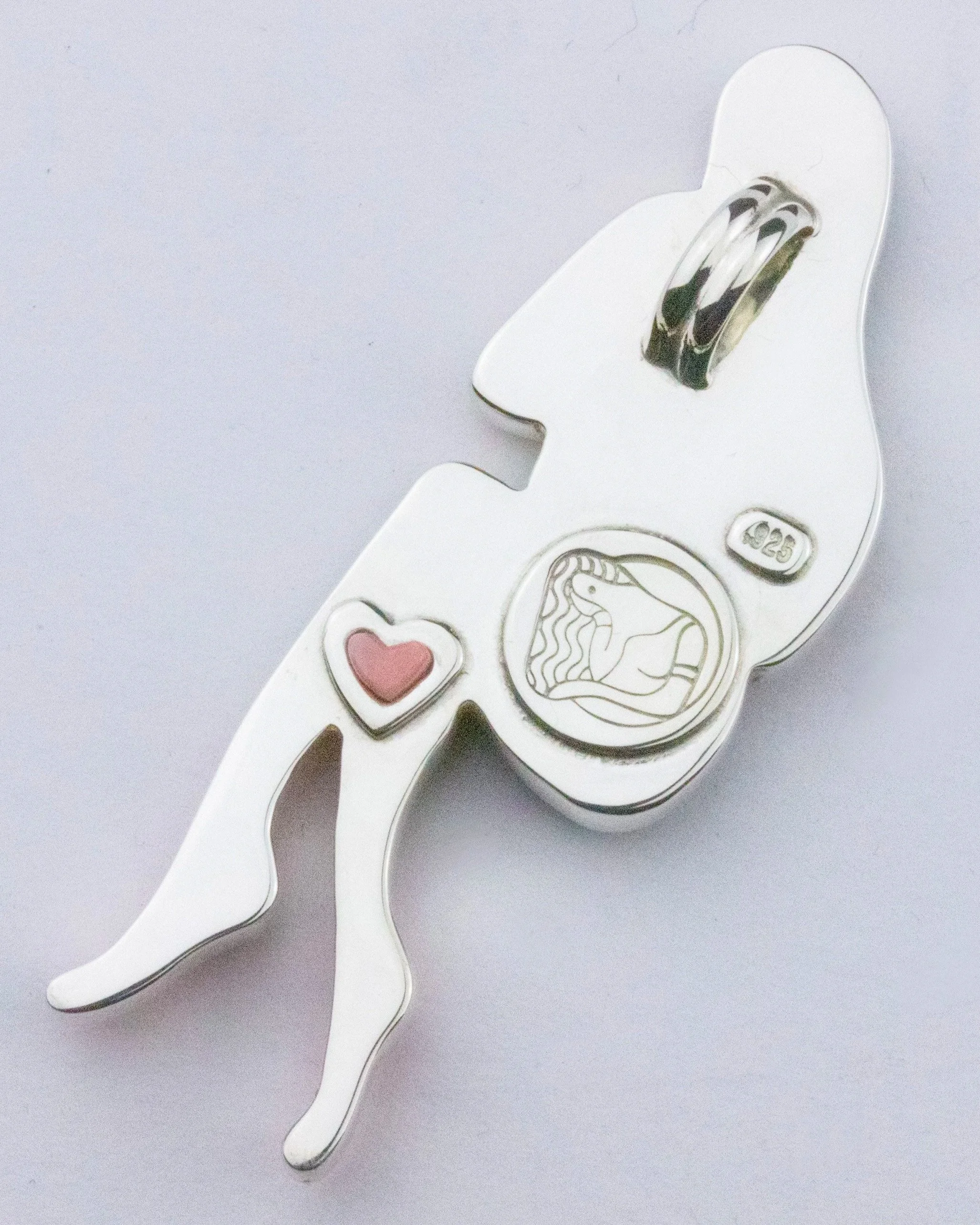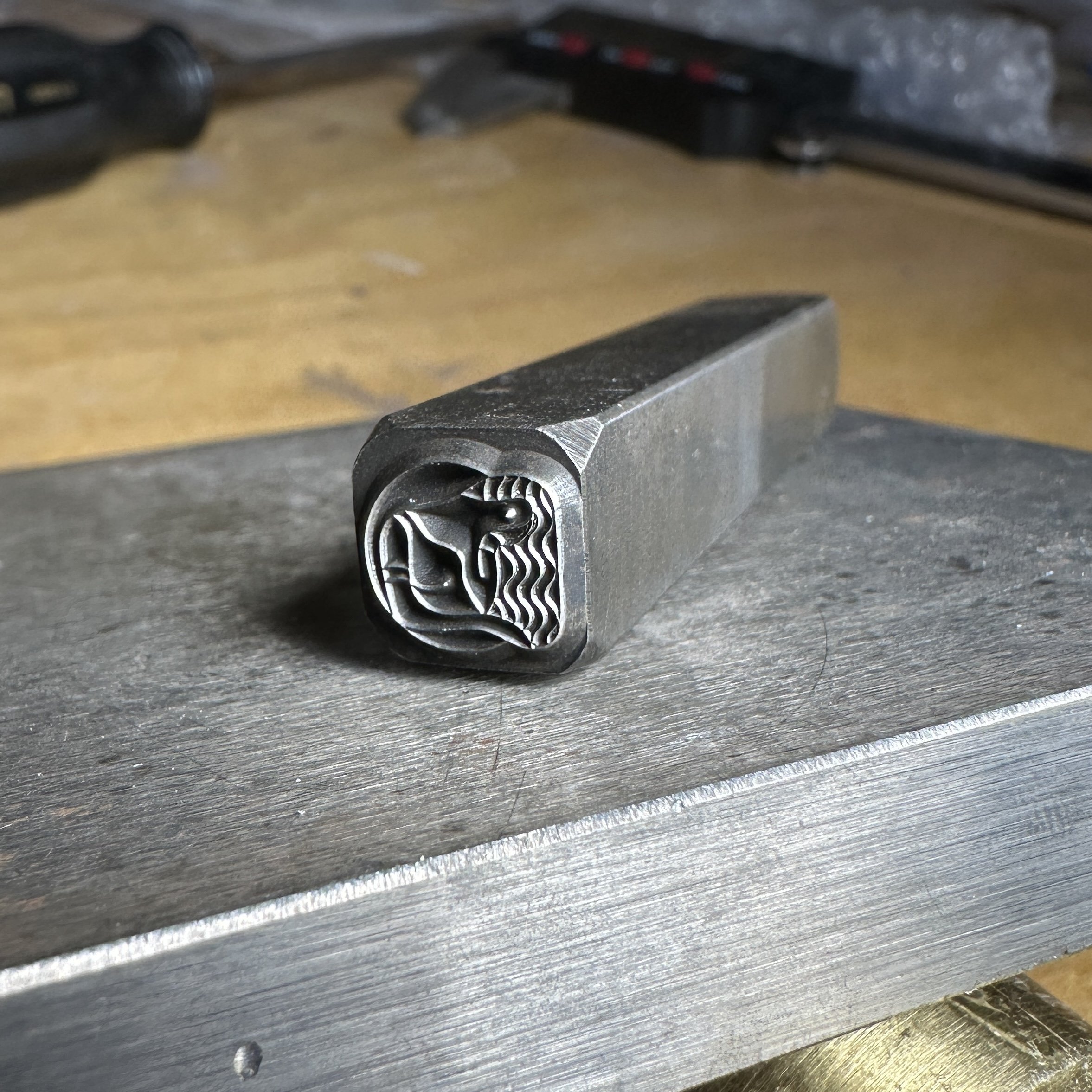What is a jewelry maker’s mark?
Caitlin Albritton’s marker’s mark seen on the back of one of her figurative inlay pendants.
Just as a painter signs her name on her artwork to let people know who made it, a maker’s mark on jewelry serves the same purpose: to identify who made that pendant, bracelet, ring, or pair of earrings.
Since there’s often not enough room on a piece of jewelry for a full hand-written signature (though you do see full names too), maker’s marks can be anything from initials to a unique symbol or design that represents the artist.
How is a maker’s mark made?
To make the mark, a jeweler needs to have a custom steel stamp made for them, which is a steel rod with the design engraved on one end.
This tool is then held against the metal as the jeweler taps a hammer into the back of the tool, leaving an imprint of the stamp into the metal.
(Pictured, you can see my first maker’s mark stamp that reads “C Albritton” on the back of one of my cameo pendants).
The maker’s mark is usually done in a hidden location on the back of the jewelry and the imprint can either be done directly on the jewelry, or done on a metal circle that is soldered to it.
This is the steel stamp I use to impress my maker’s mark into sterling silver jewelry, made as the reverse of what it should look like when stamped.
Why do jewelry makers’ marks matter?
For collectors looking for original, handmade work, a maker’s mark can help distinguish mass-produced jewelry from the hand-made.
With particularly unique pieces of jewelry, a maker’s mark can assist a collector in finding out more about its provenance if they wish to find out more about the jewelry artist (or jewelry manufacturer), their inspirations, and their collections.
Popular jewelers may have a signature style in their jewelry that others may try to imitate, so to some extent, maker’s marks can also help with authentication—showing that a piece of jewelry is from who it says it is from. (Though it should be pointed out that this isn’t the end-all-be-all as stamps of famous jewelers could certainly be forged.)
When authentication is made with the maker’s mark, a piece of jewelry can be better appraised by a jewelry appraiser who is familiar with the artist, transforming the value of the piece.
Besides the usual uses of a maker’s mark in jewelry, it’s also a way for the artist to express themselves further by using this as another creative opportunity to make the piece truly theirs. And just like how artists go through different phases and bodies of artwork, their makers mark may change as well, which could even help date the jewelry through the jeweler’s career.
Caitlin Albritton’s maker mark on the back of one of her agatized coral cuff bracelets. You can find the mark on the inside of the band.
How did I choose my maker’s mark?
Because my signature jewelry are my female figurative pendants, I wanted to choose one of them to represent me and my jewelry. You can read the story behind my logo and maker’s mark here.
How do I find a maker’s mark?
While some stamps will be big and obvious with the naked eye, some often need magnification to see the details better, especially if it is a well-worn vintage piece and the mark has gotten dings from wear and tear.
Usually maker’s marks are hidden on the backside or underneath the jewelry piece so with a ring, you would look inside the ring band. Some designs may be a bit more elaborate so you may have to look a bit harder.
I found the maker’s mark—now what?
Finding the maker’s mark doesn’t always mean you’ve cracked the code; sometimes, that’s just the beginning of your jewelry research. And while taking your jewelry to an appraiser can be helpful, there are so many jewelers out there now, as well as have been in the past so that may lead to a dead end.
There are some online jewelry maker’s mark databases where you can do some research on your own without having to spend money on an appraiser right away. In this same vein, it may also help to take a picture of the maker’s mark and run it though an image search on a search engine to help with leads.
So while maker’s marks can be a bit mysterious, it can shed a light on the story—and maker—behind the jewelry you cherish.




